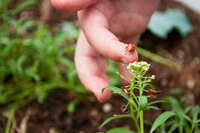Search
20 items
-
Religion and Environment Photo Gallery: 2019 Photo Contest First Prize: Todd Wynward, “Ecstacy”
Muralist Dimitri Kadiev caught painting one of four sacred murals we brought from Taos to the Capitol in Santa Fe for Global Climate Strike, Sept 20. Photo credit: Todd Wynward, TiLT [Taos Initiative for Life Together] -
Religion and Environment Photo Gallery: 2019 Photo Contest Second Prize: Mikayla Benjamin
Me and my friends were picking up trash out of a forest for class extra credit and we stumbled across this glass jar with plants growing through it, showing how even when we treat nature bad it still finds beauty in the forgotten treasures such as this glass jar being home to new life. Photo credit: Mikayla Benjamin -
Religion and Environment Photo Gallery: 2019 Photo Contest (tie for) Third Prize: Kelsey Ryan-Simkins, "Reciprocity"
2019 Photo Contest (tie for) Third Prize: Reciprocity – A young girl gently lowers a ladybug onto a flower during a ladybug release at the GrowHaus, a nonprofit urban farm. Photo credit: Kelsey Ryan-Simkins -
Religion and Environment Photo Gallery: Ann Hitzhusen
IPC Intergenerational Neighborhood Clean-up Day! Photo credit: Ann Hitzhusen -
Religion and Environment Photo Gallery: Tony Losekamp, "Hostas for Grandma"
This was in college in Clifton just off campus at University of Cincinnati. We were going to an Italian restaurant for my grandmother’s birthday. It was one of the first photos I took with my first digital camera. I still love it for the fact that these beautiful hostas were surrounded by concrete on all sides in a busy city. In a dessert of a city these were an oasis of life. Photo credit: Tony Losekamp -
Religion and Environment Photo Gallery: Liz Vaisben
Participants in the girls book and social action club, Girls Read and Do, participate in the Jewish New Year ritual of Tashlich as part of an educational session on how to ensure that our Jewish practices are harmonious with the environment (in this case, casting bird seed in lieu of the traditionally used bread crumbs — not healthful for water foul — into the water). Photo credit: Liz Vaisben -
Religion and Environment Photo Gallery: Kyle Meyaard-Schaap (4)
Evangelicals from across the country lobby on Capitol Hill for a price on carbon in 2017. Photo credit: Kyle Meyaard-Schaap -
Religion and Environment Photo Gallery: Tony Losekamp, "Close Sunflower"
This was in the community garden I started at my high school, Archbishop McNicholas High School in Cincinnati, Ohio. The sunflower was huge and the number of seeds it produced was incredible. I wanted to capture the detail in the perfectly organized seed arrangement in the flower that is one of infinite examples of an intelligent designer of creation. Photo credit: Tony Losekamp -
Religion and Environment Photo Gallery: Rongkun Liu, "Abode of Peace"
A Tibetan Buddhist Temple Perched on Hillside for Meditation Retreat. Photo credit: Rongkun Liu -
Religion and Environment Photo Gallery: 2018 Photo Contest 3rd place photo: Aminta Kilawan-Narine
2018 Photo Contest 3rd place photo: Shiva, the God of Destruction, Destroyed. Hindus have worshipped at the banks of Ganges and the shores of other bodies of water for centuries. Jamaica Bay is basically a closed system, so whatever lands in its waters stays until it is removed. The Ganges and many other bodies of water have become polluted by the use of many user groups. The Ganges, one of the major rivers of India, also known as Ganga Maa, is said to have made her abode in Shiva’s matted hair in order to prevent the destruction of Prithvi (Mother Earth). The flow of the Ganges also represents the nectar of immortality. Shiva is regarded as “the Destroyer” among the Trimurti, the Hindu Trinity of the primary aspects of the divine. He is also regarded as the patron god of yoga and the arts. Here, Shiva is found broken in the sands of Jamaica Bay, during a cleanup organized by the photographer Aminta Kilawan-Narine and her husband Rohan Narine. Photo credit: Aminta Kilawan-Narine -
Religion and Environment Photo Gallery: Tony Losekamp, "Ohio Serving the Poor"
This photo was taken on the gulf cost in Biloxi, Mississippi. It was winter break during my freshmen year at Ohio State (2013). It was a Buck-I-Serve trip. Doing an O-H-I-O is a normal occurrence, but I really like the natural beauty of the silhouette on the beach where we were staying. Photo credit: Tony Losekamp -
Religion and Environment Photo Gallery: Rohan Narine
Kali Maa under transformation after being found at Jamaica Bay during a cleanup organized by the photographer Rohan Narine and his wife Aminta Kilawan-Narine alongside other local Indo-Caribbean Hindus advocating for eco-friendly worship. Kali is an embodiment of the Goddess Durga. She is fierce and associated with empowerment or shakti. Kali means black, time, and death, thus Kali is the goddess of time and change. Although she is sometimes depicted as dark and violent, Kali Maa’s earliest incarnation is as a figure of the destruction of evil. Photo credit: Rohan Narine -
Religion and Environment Photo Gallery: Hemma Kilawan
Headless Baby Krishna. Many of the items used in worship get broken by wave and water action. This depicts what happened after a worshipper with the best of intentions, left the murthi (sculpture of Hindu deity) at Jamaica Bay Wildlife Refuge in New York City. It is said that at midnight on Janamashtami, baby Krishna, who is depicted in this murthi, was born and travelled across the Yamuna River in order to help Mother Earth bear the burden of the sins of the tyrannical leaders of the world. This murthi was found by the photographer Hemma Kilawan, during a cleanup organized by Indo-Caribbean Hindus in the New York City area. Photo credit: Hemma Kilawan -
Religion and Environment Photo Gallery: Jonathan Lacock-Nisly
Catholic school children carry signs with quotes from Pope Francis during the September 20th, 2019 Youth Climate Strike at the Capitol. Photo credit: Jonathan Lacock-Nisly -
Religion and Environment Photo Gallery: Julie Laudick (1)
Composting at Shepherd’s Corner Ecology Center. This process is a great metaphor for reconciliation. When we bring the rotting fruits and invasive weeds of our lives to confession, God transforms them into rich material for new growth. Photo credit: Julie Laudick -
Religion and Environment Photo Gallery: Julie Laudick (2)
A bountiful harvest of paw paws. Foraging for this native Ohio fruit is a Garden of Eden experience. We can share the joys of the harvest without the toil of cultivation. Photo credit: Julie Laudick -
Religion and Environment Photo Gallery: Julie Laudick (3)
Soil samples from the garden plots at Shepherd’s Corner Ecology Center. Can you tell which plot received the heaviest application of sheep manure? Photo credit: Julie Laudick -
Religion and Environment Photo Gallery: Julie Laudick (4)
Feeding sheep. Long-time volunteer at Shepherd’s Corner Ecology Center gives the sheep a treat after pulling out old collard greens that are bound for the compost pile. The greens were fertilized by previous years of sheep manure. From manure they came, to manure they shall return. Photo credit: Julie Laudick -
Religion and Environment Photo Gallery: Julie Laudick (5)
Volunteers from the OSU Newman Center walk down an alley to return tools to a shed after a satisfying morning of work at Franklinton Farms. Photo credit: Julie Laudick -
Religion and Environment Photo Gallery (Submission by Jennet Nedirmammedova)
A wandering student on campus appreciating the pattern of God’s signature in shaping continuous creation to illuminate Own signs onto awe sensed sentient beings. Photo credit: Jennet Nedirmammedova




















